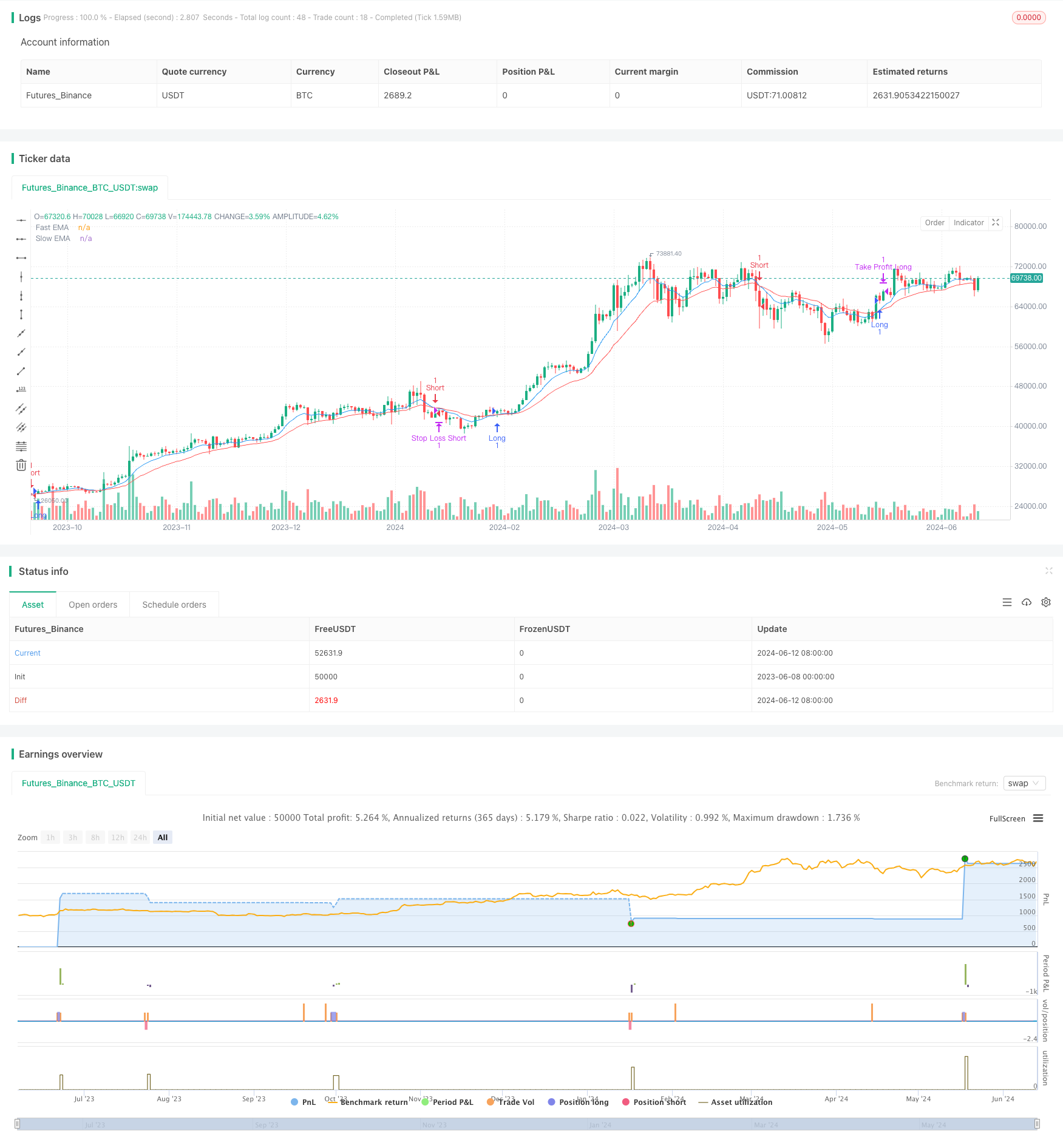
概述
该策略利用两条不同周期的指数移动平均线(EMA)的交叉信号来捕捉市场的短期动量,当快线从下向上穿越慢线时开多头仓位,当快线从上向下穿越慢线时开空头仓位。同时设置了止损和止盈来控制风险和锁定利润。这是一个简单而经典的基于动量效应的短线交易策略。
策略原理
- 计算两条不同周期的EMA,默认参数为9周期和21周期,这两个参数可以根据市场特点和个人偏好进行调整。
- 当快线EMA从下向上穿越慢线EMA时,产生做多信号,开多头仓位。
- 当快线EMA从上向下穿越慢线EMA时,产生做空信号,开空头仓位。
- 在开仓的同时,根据当前仓位的开仓价和风险偏好设置对应的止损价和止盈价。
- 当价格触及止盈价或止损价时,平掉当前仓位,等待下一个交易信号的出现。
策略优势
- 简单易用:该策略逻辑清晰,只需要两条不同周期的EMA线就可以实现,非常简单易懂,适合新手快速上手。
- 适合短线交易:EMA对价格的变化较为敏感,能够快速反应市场的短期趋势,非常适合短线交易者捕捉市场的短期波动机会。
- 趋势跟踪:EMA是一个滞后性指标,但也是一个非常好的趋势跟踪指标,EMA交叉策略能帮助交易者顺应趋势方向交易。
- 风险可控:策略中设置了百分比止损和止盈,虽然盈亏比不算太高,但在市场趋势不明朗或波动较大时也能起到一定的保护作用,降低账户爆仓风险。
策略风险
- 频繁交易:该策略相对于长线策略交易频率会较高,在市场震荡期间可能会出现频繁开平仓的情况,手续费会明显增加,对账户资金产生一定的拖累。
- 参数优化:EMA的参数选择对策略表现有很大影响,最优参数可能会因市场状态变化而失效,需要定期检查和调整参数。
- 盈亏比风险:目前示例代码的止损和止盈设置均为固定百分比,实际上盈亏比并不太理想,在一些市场状态下,策略连续亏损的次数可能会较多。
- 趋势洗牌:在市场从震荡转为趋势初期,该策略可能会出现方向感识别滞后而导致的连续亏损。
策略优化方向
- 优化止损止盈:根据市场波动特性,选择更合适的止损止盈设置方式,比如使用ATR、百分比追踪止损等,提高策略的盈亏比和风险回报。
- 过滤震荡行情:搭配其他技术指标或量价指标对EMA交叉信号进行二次确认,比如判断ADX是否向上突破某一阈值再开仓,降低频繁交易风险。
- 优化仓位管理:可以考虑逐步建仓,在趋势明朗时加大仓位,震荡时减小仓位,降低资金波动。
- 组合不同周期:用多个不同参数的EMA组合来产生开平仓信号,比如中短期EMA交叉作为入场信号,长期EMA作为趋势过滤,提高趋势识别的准确性。
- 结合宏观分析:将策略与宏观经济分析相结合,在宏观形势明朗时再使用该策略,提高策略在中长期内的表现。
总结
EMA交叉动量短线交易策略是一个简单易用的短线交易策略,适合初学者快速实践和熟悉量化交易的流程。该策略可以捕捉短期的动量效应,顺应市场趋势方向,同时设置了固定百分比止损止盈来控制风险。但是该策略也存在频繁交易、盈亏比不高、趋势识别滞后等风险。可以从优化止损止盈方式、过滤震荡行情、动态调整仓位、组合不同周期、结合宏观分析等方面对策略进行优化和改进,以期提高策略的风险回报和稳定性。
策略源码
/*backtest
start: 2023-06-08 00:00:00
end: 2024-06-13 00:00:00
period: 1d
basePeriod: 1h
exchanges: [{"eid":"Futures_Binance","currency":"BTC_USDT"}]
*/
//@version=5
strategy("Scalping Strategy", overlay=true)
// Parameters
length_fast = input.int(9, title="Fast EMA Length", minval=1)
length_slow = input.int(21, title="Slow EMA Length", minval=1)
stop_loss_pct = 0.7 // Risk 0.7% of capital
take_profit_pct = 0.5 // Target 0.5% of capital
// Calculate EMAs
ema_fast = ta.ema(close, length_fast)
ema_slow = ta.ema(close, length_slow)
// Plot EMAs
plot(ema_fast, color=color.blue, title="Fast EMA")
plot(ema_slow, color=color.red, title="Slow EMA")
// Trading logic
long_condition = ta.crossover(ema_fast, ema_slow)
short_condition = ta.crossunder(ema_fast, ema_slow)
// Calculate stop loss and take profit levels
stop_loss_long = strategy.position_avg_price * (1 - stop_loss_pct / 100)
take_profit_long = strategy.position_avg_price * (1 + take_profit_pct / 100)
stop_loss_short = strategy.position_avg_price * (1 + stop_loss_pct / 100)
take_profit_short = strategy.position_avg_price * (1 - take_profit_pct / 100)
// Enter and exit trades
if (long_condition)
strategy.entry("Long", strategy.long)
if (short_condition)
strategy.entry("Short", strategy.short)
// Exit long trades
if (strategy.position_size > 0)
strategy.exit("Take Profit Long", "Long", limit=take_profit_long)
strategy.exit("Stop Loss Long", "Long", stop=stop_loss_long)
// Exit short trades
if (strategy.position_size < 0)
strategy.exit("Take Profit Short", "Short", limit=take_profit_short)
strategy.exit("Stop Loss Short", "Short", stop=stop_loss_short)
相关推荐